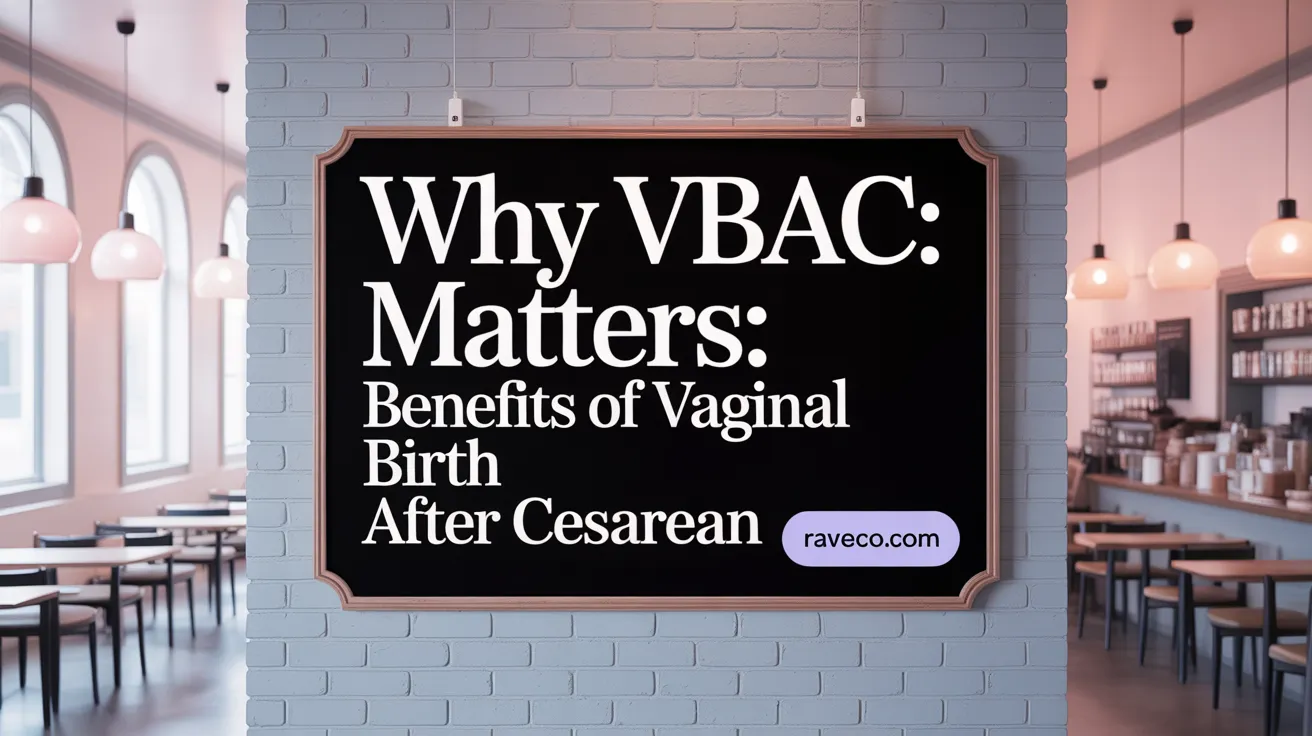Understanding VBAC: Clearing Up Common Misconceptions and Highlighting Realities

Introduction to VBAC: Separating Myths from Facts
Understanding VBAC and TOLAC
Vaginal Birth After Cesarean (VBAC) refers to the process of delivering a baby vaginally after having a previous cesarean section. The trial of labor after cesarean (TOLAC) is the attempt to have a vaginal delivery and is a monitored medical process to assess safety throughout labor.
Common Misconceptions About VBAC
VBAC is often misunderstood, with concerns around safety being a primary factor. One common myth is that attempting VBAC dramatically increases the risk of uterine rupture, but research shows this risk to be less than 1% for most women, especially those with a low transverse incision from the prior C-section. Further, some believe VBAC is not offered or available broadly; however, many hospitals, especially those with experienced obstetricians, do facilitate VBAC with proper monitoring and emergency readiness.
The Importance of Individualized Care
Each woman's suitability for VBAC depends on her unique medical history including the type of uterine incision, number of previous C-sections, and overall health status. Risk factors such as previous uterine ruptures, certain medical conditions, or multiple prior cesareans may preclude a safe VBAC attempt. Consulting with a knowledgeable healthcare provider early in pregnancy is crucial to make an informed decision. This personalized approach ensures that the delivery plan aligns with the woman's health needs and preferences, aiming for the best possible outcome for mother and baby.
Who Is a Candidate for VBAC? Eligibility and Considerations
What are the key factors determining candidacy for VBAC?
Candidates for vaginal birth after cesarean (VBAC) are assessed carefully based on several important factors to ensure safety for both mother and baby.
One of the most critical considerations is the type of previous uterine incision. Women with a low transverse (horizontal) uterine incision from a prior C-section are typically eligible for attempting VBAC. This incision type carries the lowest risk of uterine rupture during labor, which occurs in fewer than 1% of such cases (Uterine rupture risk in VBAC under 1%, Impact of vertical vs transverse C-section scars, Low transverse incision benefits). Conversely, vertical uterine incisions, especially classical (high vertical) ones, generally contraindicate VBAC due to significantly higher rupture risks (Vertical uterine incisions and VBAC).
Health conditions also influence eligibility. Women with a history of uterine rupture, multiple uterine surgeries, active genital infections (like herpes), maternal diabetes, or heart disease typically should not attempt VBAC (Health conditions contraindicating VBAC, Medical conditions affecting VBAC). Advanced maternal age, high body mass index (BMI), preeclampsia, or recent cesarean (less than 18-19 months prior) further reduce suitability (Preeclampsia and VBAC risks, Timing since last C-section and VBAC).
A successful previous vaginal birth, especially after a cesarean, strongly predicts a higher chance of VBAC success. This experience indicates the uterus and pelvis can accommodate vaginal delivery (Prior vaginal delivery impact on VBAC success, Success after one C-section.
The number of prior cesareans is another crucial factor. While women with one prior C-section and a low transverse incision are ideal candidates, those with two or more previous cesareans face increased risks such as uterine rupture and placental complications, making VBAC less advisable (VBAC considerations for women with multiple cesareans, Risks of multiple previous C-sections.
In summary, a candidate for VBAC is typically a healthy woman with a prior low transverse uterine incision, no contraindicating health problems, previous vaginal delivery history that supports success, and one or possibly two prior cesareans. Decisions should be individualized and involve discussions with experienced obstetricians in well-equipped hospitals, such as those available in Queens, NY (Experienced healthcare providers for VBAC in Queens, Vaginal Birth After Cesarean options in Queens NY), to safely manage labor and any emergency situations (Hospital requirements for safe VBAC delivery, Emergency cesarean delivery facilities).
Safety and Risks: Evaluating VBAC Versus Repeat Cesarean

What are the risks associated with VBAC compared to repeat cesarean?
[Vaginal birth after cesarean (VBAC)] carries a uterine rupture risk of less than 1%, a rare but potentially life-threatening event for both mother and baby. Despite this, VBAC generally offers advantages over repeat cesarean deliveries.
Statistical Risks in VBAC and Repeat Cesarean
The primary VBAC risk is uterine rupture due to the previous incision site on the uterus, especially if it is a low transverse incision, which is associated with the lowest risk (about 0.9%). Other risks include infection and possible emergency cesarean if complications arise during labor. In contrast, repeat cesareans carry risks like surgical infection, higher blood loss, and increased likelihood of placental complications and adhesions in future pregnancies.
Blood Loss and Recovery
VBAC tends to involve less blood loss compared to repeat C-sections, leading to fewer transfusions and a generally quicker postpartum recovery. Women who have a successful VBAC often experience shorter hospital stays and faster return to normal activities than those undergoing repeat cesarean, whose recovery typically takes longer due to the surgical nature of the delivery.
Hospital Preparedness and Monitoring
Safety during VBAC requires that labor take place in hospitals fully equipped for emergency cesarean deliveries. Continuous fetal heart rate monitoring is essential to detect any signs of distress or uterine rupture early, allowing prompt intervention. Facilities should have 24/7 anesthesia, blood bank services, and neonatal intensive care units (NICU).
Emergency Interventions and Maternal-Fetal Safety
If complications such as uterine rupture or fetal distress occur, immediate cesarean delivery is critical. The medical team—including obstetricians, anesthesiologists, and nursing staff—works together to ensure rapid response and the safety of mother and baby.
VBAC offers a safe alternative to repeat cesarean for many women, with benefits including less surgical trauma, reduced infection risk, and quicker recovery, provided that hospitals are prepared for emergencies and proper monitoring is maintained throughout labor.
The Decision-Making Process: Personalized Care in VBAC Planning

How does personalized care impact women's health outcomes in obstetrics and gynecology?
Personalized care greatly improves women's health outcomes by incorporating their unique medical histories, obstetric risks, and personal preferences. This tailored approach fosters informed, shared decision-making between patients and their healthcare providers, leading to better adherence to birth plans and higher satisfaction. For further insights, see Myths and Facts About Vaginal Birth After Cesarean and VBAC success rate and considerations.
Importance of patient health history and preferences
Each woman's candidacy for VBAC depends heavily on her individual health history, such as the type of uterine incision, number of prior C-sections, and any previous complications. Preferences also influence the choice, as women weigh recovery times, surgical risks, and future pregnancy plans. Detailed factors influencing VBAC eligibility can be found at Deciding Between a VBAC and a Repeat Cesarean and Vaginal birth after Cesarean overview.
Role of healthcare providers in shared decision-making
Healthcare providers play a pivotal role in guiding women through the risks and benefits of VBAC versus repeat cesarean. They evaluate medical factors and support patients in making decisions aligned with their values and health needs, ensuring safety and personalized care. For guidance on consulting healthcare providers, refer to Consulting healthcare providers on VBAC and Shared decision-making for VBAC.
Utilization of VBAC success calculators as a guide, not a decision tool
VBAC success calculators offer estimates based on clinical factors but are not definitive. They serve best as tools within the broader shared decision-making process, helping frame expected outcomes while not replacing clinical judgment. Learn more about using VBAC calculators and factors affecting success at VBAC success calculators and decision making.
Impact of personal values and reproductive goals on delivery choices
A woman’s personal values and goals—such as the desire for vaginal birth experience, quicker recovery, or family size considerations—influence VBAC planning. This personalized approach respects patient autonomy and tailors delivery decisions to long-term reproductive health. See Benefits and considerations of VBAC and Patient preferences in cesarean versus VBAC for more.
By combining medical insights with patient-centered dialogue, VBAC planning prioritizes both safety and individual preferences, leading to optimized care and better maternal outcomes in Queens, NY and beyond. For local resources and experienced providers, visit Vaginal Birth After Cesarean options in Queens NY and Experienced healthcare providers for VBAC in Queens.
Benefits of VBAC: Why Vaginal Birth After Cesarean Matters

What advantages does VBAC offer compared to repeat cesarean delivery?
Vaginal Birth After Cesarean (VBAC) is a safe and viable option for many women, offering several significant advantages over repeat cesarean sections. One of the most notable benefits is a shorter recovery time. Women who have a successful VBAC typically experience quicker postpartum recovery and shorter hospital stays compared to those undergoing another C-section. This allows mothers to return to their daily routines and care for their newborns with less delay (VBAC recovery advantages.
VBAC also reduces the risk of surgical complications. Since repeat cesareans are major surgeries, they carry risks such as infections, increased blood loss, and injury to bladder or bowel. With VBAC, women avoid an additional abdominal surgery, which lowers the chance of these complications and reduces the risk of wound infection and anesthesia-related issues (Myths and Facts About C-Sections).
Moreover, VBAC can reduce risks in future pregnancies. Multiple cesarean deliveries increase the likelihood of placental complications such as placenta previa and accreta, which can lead to severe bleeding and require complex interventions. By avoiding repeated uterine surgery through VBAC, women lower the chance of these significant issues, contributing to safer pregnancies and deliveries in the future (Vaginal Birth After C-Section (VBAC) - Risks of VBAC).
Babies also benefit from VBAC. Vaginal birth promotes improved lung clearance, helping newborns breathe more easily at birth. Additionally, passing through the birth canal supports the infant’s immune system by exposing them to beneficial bacteria, offering immune advantages not typically present in cesarean deliveries (Benefits of VBAC.
In summary, VBAC offers compelling benefits including faster recovery, fewer surgical risks, safer future pregnancies, and neonatal health advantages, making it an important choice to consider for suitable women after a previous cesarean (Myths and Facts About Vaginal Birth After Cesarean).
Dispelling Myths: Common Misconceptions About VBAC

What are common myths about VBAC, and how do facts counter these misconceptions?
Many misconceptions surround vaginal birth after cesarean (VBAC), creating unnecessary fear and confusion. A common myth is that VBAC carries extremely high risks, particularly uterine rupture. However, research shows that uterine rupture happens in fewer than 1% of VBAC attempts, which is a very low incidence.
Another misconception is that VBAC is legally restricted or unavailable in many areas. In reality, VBAC is legal across all U.S. states, although some medical facilities may not offer it due to resource limitations or institutional policies.
Many assume women who have had multiple previous C-sections cannot pursue VBAC. While multiple cesareans increase risks, some women with more than one prior C-section may still be candidates for VBAC depending on the type of uterine incision and overall health.
Additionally, VBAC is often thought to be impossible for women with twin pregnancies. Current guidelines suggest that low-risk twin pregnancies can also be considered for VBAC under expert supervision.
Clarifying these facts helps expectant mothers make informed decisions and encourages discussions with experienced obstetricians, especially in areas like Queens, NY, where providers can tailor care based on individual histories and preferences.
Hospital and Provider Role: Ensuring Safe VBAC Outcomes in Queens, NY

Why Delivering in Hospitals Equipped for Emergency C-Section Matters
Delivering in a hospital that can immediately perform an emergency cesarean section surgery is critical for women attempting a vaginal birth after cesarean (VBAC). Although VBAC is safe for many, the rare risk of uterine rupture—occurring in fewer than 1% of cases—necessitates readiness for urgent surgical intervention to protect both mother and baby.
Multidisciplinary Team Approach to VBAC Care
Successful VBAC outcomes rely on a collaborative team of specialists including obstetricians, anesthesiologists, pediatricians, and nursing staff. These experts work together to monitor labor closely, manage anesthesia safely, and provide neonatal care. Continuous fetal monitoring and the availability of advanced emergency support are essential components in managing any arising complications.
Services Offered by Woman-Led Obstetrics and Gynecology Providers
Women-led healthcare providers specializing in obstetrics and gynecology in Queens, NY, typically offer comprehensive, personalized care throughout pregnancy and postpartum. Their services include prenatal checkups, labor and delivery support, and postpartum recovery management. Many integrate holistic care, addressing mental health, fertility concerns, prenatal genetic screening, and robotic-assisted minimally invasive surgical techniques, optimizing health outcomes for mothers and babies.
Why Women May Prefer Woman-Led Providers
Patients often value woman-led providers for their empathetic, patient-centered approach. These providers tend to create a trusting environment, fostering open discussions about reproductive, sexual, and gender-specific health concerns. This level of understanding and comfort can improve patient satisfaction and encourage active participation in care decisions.
In Queens, NY, accessing obstetric care through experienced, woman-led teams that emphasize holistic support and collaboration within well-equipped hospital settings contributes significantly to safe VBAC experiences and improved maternal health.
Future Directions: Advances Shaping Women's Healthcare and Their Impact on VBAC
What advances are currently shaping women's healthcare in obstetrics and gynecology?
Women’s healthcare is evolving rapidly with innovations improving safety, personalization, and access to care. Robotic-assisted minimally invasive surgical techniques allow for precise procedures with less trauma and quicker recoveries. This development can reduce complications associated with repeat cesareans, potentially making vaginal birth after cesarean (VBAC) more viable for some women.
Enhanced prenatal genetic screening now provides early risk assessments for fetal and maternal conditions, aiding in safer pregnancy planning. Such screening permits healthcare providers to tailor care plans well before labor, improving outcomes for pregnancies following cesarean deliveries.
Telemedicine has revolutionized obstetric care by expanding access to consultations and follow-ups, especially for women in remote areas or with mobility challenges. Regular virtual check-ins enable ongoing monitoring of VBAC candidates, ensuring timely support and decision-making.
Moreover, holistic care models that integrate mental health services alongside obstetric care help address the emotional and psychological needs of pregnant women. This integrated approach contributes to overall wellbeing, better preparing women for childbirth, including those planning VBAC.
Together, these advances foster safer and more personalized obstetric care. By addressing surgical risks, enhancing prenatal assessments, improving healthcare accessibility, and supporting mental health, they positively impact the experience and outcomes of women considering VBAC.
Making Informed Choices: Empowering Women through Knowledge and Support
Early Consultation and Individualized Assessment for VBAC
Women considering vaginal birth after cesarean (VBAC) are encouraged to consult with their healthcare provider early in pregnancy. This initial discussion helps assess individual health, previous pregnancy and delivery history, and the type of uterine incision from prior cesareans. Since eligibility depends on detailed factors such as the number of previous C-sections, scar type, and overall uterine health, a personalized evaluation is vital to ensure safety.
Balancing Risks and Benefits with Trusted Healthcare Providers
Choosing between VBAC and repeat cesarean involves weighing potential advantages against risks. VBAC offers benefits like shorter recovery, less blood loss, and reduced infection risk. However, rare but serious complications such as uterine rupture must be carefully considered. Women are encouraged to engage in open dialogue with their trusted obstetricians who can provide tailored information, monitor labor closely, and ensure emergency surgical support is available.
The Role of Woman-Led, Comprehensive Obstetric Care
Comprehensive care that centers on the woman's preferences, medical history, and values is essential. In specialized centers, including those in Queens, NY, experienced providers proficient in VBAC and repeat cesarean care support shared decision-making. This approach respects individual choices while prioritizing safety, enabling women to navigate their childbirth options with confidence.
Supporting Empowered Decisions About Childbirth
Empowerment comes from knowledge and support. Women should feel informed about their options, understand possible outcomes, and be supported in making decisions aligned with their personal goals and health needs. Hospitals equipped with emergency care create a safe environment where women can attempt VBAC with reassurance. Through collaborative care, women achieve positive birth experiences that honor their autonomy and well-being.




.png)